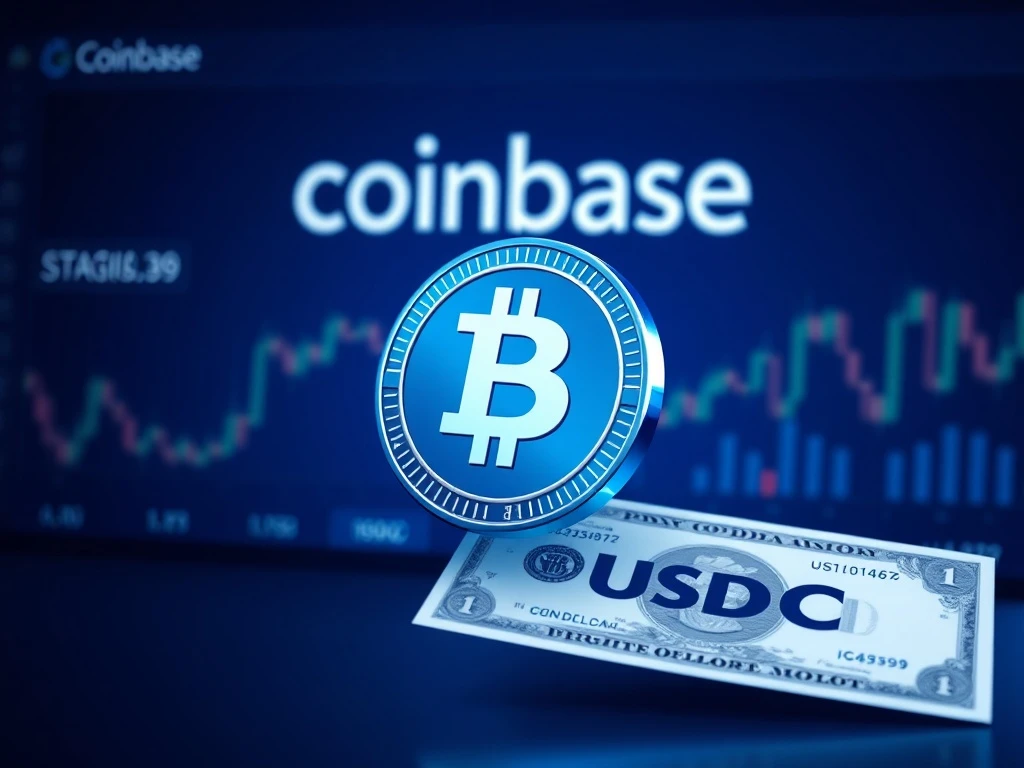The cryptocurrency market constantly evolves. Therefore, staying informed about major exchange policy changes remains crucial for investors and businesses. Recently, Coinbase, a leading crypto exchange, announced a significant update regarding its Coinbase USDC fees. This change introduces a 0.1% charge on large conversions of USDC stablecoin to US dollars. This move has drawn considerable attention across the crypto community. Understanding the details of these new Coinbase USDC fees is vital for anyone engaging in substantial stablecoin transactions.
Understanding the New Coinbase USDC Fees
Coinbase will soon implement a 0.1% fee for specific USDC to US dollar conversions. This policy targets net conversions exceeding $5 million within a 30-day rolling period. Previously, users enjoyed a much higher fee-free threshold. The new fee structure will begin on August 13. Specifically, it applies to the net amount of USDC converted to USD, after deducting any USDC purchases. For instance, if a user converts $6 million USDC to USD and purchases $1 million USDC within 30 days, the fee applies to $5 million of that conversion.
This adjustment significantly lowers the previous fee-free limit. Historically, Coinbase offered free conversions for net USDC to USD swaps up to $40 million over a 30-day period. Beyond this, fees ranged from 0.05% for amounts between $40 million and $100 million, scaling up to 0.2% for conversions exceeding $200 million. Consequently, the new $5 million threshold marks a considerable shift. Many users, especially institutional ones, will now face charges on transactions that were previously free. This change reflects a broader trend among exchanges to optimize revenue streams.
Why Coinbase is Adjusting its Fee Structure
Coinbase’s decision to introduce these new Coinbase USDC fees directly relates to its recent financial performance. The exchange has missed revenue expectations for two consecutive quarters. This puts pressure on the company to find new income sources. Last week, Coinbase shared its second-quarter results. These figures showed a miss on both revenue and earnings. Subsequently, the company’s shares experienced a notable decline.
Despite these overall revenue challenges, Coinbase’s stablecoin-related revenue has shown resilience. It actually rose by 12% year-on-year, reaching $332 million. However, this growth was not enough to offset declines in other areas. The company’s first-quarter revenue also fell short of analyst expectations. This marks two quarters in a row of underperformance. Therefore, the introduction of these new fees appears to be a strategic move. Coinbase aims to bolster its earnings amidst a challenging market environment. Furthermore, this step could help diversify its revenue away from volatile trading fees.
Community Reactions and Coinbase’s “Experiment”
The announcement of the new Coinbase USDC fees sparked immediate reactions within the crypto community. Bankless co-founder Ryan Sean Adams expressed his concern on X (formerly Twitter). He stated, “I don’t love the precedent here.” Adams questioned the potential for the fee-free threshold to drop further, saying, “What if this dropped to $10k. Feels like bank fees again.” This sentiment highlights a common worry among crypto users. Many fear that exchanges might increasingly adopt traditional financial service models, including more restrictive fee structures.
Will McComb, Coinbase’s senior product manager for stablecoins, responded to the criticism. He explained that the exchange is “running an experiment.” McComb clarified, “We’re running an experiment to better understand how fees impact USDC off-ramping.” He also noted that some competitors already charge higher fees for converting stablecoins back to fiat currency. McComb assured users that Coinbase is “carefully monitoring all feedback.” He reiterated the company’s commitment to ensuring Coinbase remains “the best place to use stablecoins.” This suggests the company is evaluating the market’s response to these new fees.
The Strategic Angle: Addressing Stablecoin Arbitrage
Some commentators offered alternative explanations for the new Coinbase USDC fees. Crypto influencer Jordan Fish, known as “Cobie,” suggested a strategic reason. He speculated that the fee could deter arbitrageurs. Specifically, these users convert Tether (USDT) to USDC to off-ramp into US dollars for free. This practice, according to Cobie, reduces USDC supply while maintaining USDT supply. He explained, “Tether has an exit fee, which means the cheapest practical route was to swap USDT to USDC and then off-ramp USDC to USD.”
Coinbase CEO Brian Armstrong seemingly confirmed this theory. He replied to Fish’s comment with a simple “yep.” This indicates that managing arbitrage opportunities plays a role in the decision. Tether, the largest stablecoin by market capitalization, charges a fee of 0.1% or $1,000, whichever is higher, for converting USDT. However, it requires a minimum redemption value of $100,000. While USDT’s market capitalization increased by 20% this year, USDC’s market capitalization grew even more, by 47% during the same period, according to DefiLlama. This disparity might create profitable arbitrage opportunities that Coinbase seeks to mitigate.
Unpacking the Costs: An Analyst’s View on Coinbase USDC Fees
Bloomberg ETF analyst James Seyffart offered another perspective on the new Coinbase USDC fees. He believes Coinbase is likely incurring costs in managing USDC conversions. The exchange is now passing these costs onto its users. Seyffart drew a parallel to the traditional financial market. He remarked, “This feels similar to a create/redeem fees for an ETF.” Exchange-Traded Funds (ETFs) often charge fees for the creation and redemption of shares. These fees cover the operational costs involved in managing the fund’s underlying assets.
Seyffart further elaborated on his hypothesis. He stated, “If they actually have to facilitate creating and redeeming USDC based on one way flow from someone they are [probably] incurring some sort of cost to do that.” He concluded by suggesting that Coinbase is not just recovering costs but potentially adding a margin. “My guess is they’re offloading that cost … and then some,” he added. This perspective highlights the operational complexities and expenses involved in maintaining stablecoin liquidity and conversion services on a large scale. Consequently, it justifies the need for such fees from a business standpoint.
Coinbase’s Financial Performance Under Scrutiny
The introduction of these new fees coincides with a challenging period for Coinbase’s financial health. The company missed analysts’ revenue estimates for the quarter ending June. Coinbase reported a revenue of $1.5 billion. Analysts had projected revenues ranging between $1.56 billion and $1.59 billion. Following the release of its second-quarter earnings report, the company’s stock saw an 8% decline. This drop underscored investor concerns about the exchange’s profitability.
Furthermore, Coinbase’s first-quarter performance also painted a grim picture. Its total revenue dropped by 10% in Q1. Its net income plummeted by a staggering 95%. These significant losses were primarily due to unrealized losses on the company’s crypto holdings. Such financial pressures often prompt companies to explore new revenue streams or adjust existing pricing models. Therefore, the new Coinbase USDC fees are a direct response to these financial headwinds. They represent an effort to stabilize and improve the company’s fiscal outlook.
In conclusion, the new Coinbase USDC fees mark a notable change in the stablecoin landscape. They reflect Coinbase’s strategic efforts to address financial pressures and operational costs. While these fees may impact large-volume users, they also highlight the evolving dynamics of cryptocurrency exchanges. Users should remain aware of these changes and adjust their strategies accordingly.
Frequently Asked Questions (FAQs)
What are the new Coinbase USDC fees?
Coinbase will levy a 0.1% fee on net conversions of USDC to US dollars that exceed $5 million within a 30-day rolling period. This fee applies to the amount above the $5 million threshold.
When will the new Coinbase USDC fees take effect?
The new fee structure for USDC to US dollar conversions will commence on August 13.
Why is Coinbase implementing these fees?
Coinbase is introducing these fees primarily due to missing revenue expectations for two consecutive quarters. The fees aim to boost revenue and cover operational costs associated with managing large stablecoin conversions, potentially also curbing arbitrage activities.
How do the new Coinbase USDC fees compare to competitors?
Coinbase’s senior product manager stated that some competitors already charge higher fees for off-ramping stablecoins to fiat. However, specific comparisons would depend on the competitor and the transaction volume.
What is stablecoin arbitrage and how does it relate to Coinbase USDC fees?
Stablecoin arbitrage involves exploiting price differences or fee structures between different stablecoins or exchanges. For instance, users might convert Tether (USDT) to USDC and then off-ramp USDC to USD for free, bypassing Tether’s own redemption fees. Coinbase’s new fees may deter this specific arbitrage strategy.
What is the impact of these Coinbase USDC fees on users?
The new fees will primarily affect users who conduct large-volume USDC to USD conversions exceeding $5 million within a 30-day period. These users will now incur a charge on transactions that were previously fee-free, potentially increasing their operational costs.
























